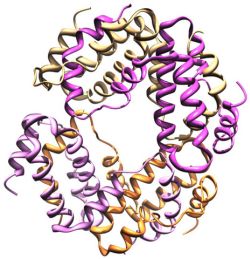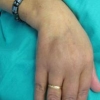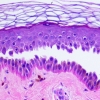La disregolazione nel sistema dell'interferone di tipo I nella dermatomiosite clinicamente amiopatica ad insorgenza nell'adulto, potrebbe dare un importante contributo allo sviluppo della malattia polmonare interstiziale
 È stato ipotizzato che l'infezione virale possa essere uno dei potenziali agenti eziologici per la dermatomiosite clinicamente amiopatica (CADM) ad insorgenza nell'adulto. La patogenesi molecolare rimane tuttora sconosciuta.
È stato ipotizzato che l'infezione virale possa essere uno dei potenziali agenti eziologici per la dermatomiosite clinicamente amiopatica (CADM) ad insorgenza nell'adulto. La patogenesi molecolare rimane tuttora sconosciuta.
Obiettivi: Scoprire se la disregolazione del sistema dell'interferone di tipo I (IFN) è coinvolta nella patogenesi di CADM.
Metodi: Sono stati studiati 16 pazienti con CADM e successivamente confrontati con soggetti di controllo sani (n = 20), con pazienti con dermatomiosite classica (DM, n = 16) e con polimiosite (PM, n = 16). Sono state rilevate le espressioni in mRNA per i geni del recettore toll-like seriale (TLR2, TLR3, TLR4, TLR7, TLR8 e TLR9) e per i geni regolati da IFN di tipo I (IRF7, ISG15 e MxA) in leucociti del sangue periferico (PBL), tutto ciò mediante l'analisi real-time della reazione a catena della polimerasi. È stato testato il livello di IFN-α nel sangue attraverso il saggio immunoassorbente legato all'enzima.
Risultati: Le espressioni in mRNA di TLR7, TLR9 e IRF7 sono risultate molto elevate nel PBL di pazienti con CADM rispetto ai controlli. Una sopra-regolazione dei geni ISG15 e MxA è stata rilevata nel PBL da pazienti con CADM, nonché dai pazienti con DM classico. Tra i quattro gruppi di studio, la sovrapproduzione di IFN-α nel sangue è stata più significativa nel gruppo CADM. Soprattutto, il livello di IFN-α è stato ovviamente alto nel sottogruppo di pazienti con malattia interstiziale polmonare (ILD) clinica, tra quei pazienti con CADM. Sono state trovate correlazioni positive tra la concentrazione di IFN-α ed altri fattori prognostici sfavorevoli di ILD associata a CADM.
Conclusioni: I nostri dati suggeriscono che la disregolazione del sistema dell'IFN di tipo I può essere implicata nella patogenesi di CADM. IFN-α può essere un biomarker utile per valutare la gravità della malattia ILD associata a CADM.
Storia della pubblicazione:
Titolo: Dysregulation of the type I interferon system in adult-onset clinically amyopathic dermatomyositis has a potential contribution to the development of interstitial lung disease
Rivista: British Journal of Dermatology. doi: 0.1111/j.1365-2133.2012.11145.x
Autori: W.C. Sun, Y.C. Sun, H. Lin, B. Yan, G.X. Sh
Affiliazioni: The Division of Rheumatology, State Key Laboratory of Biotherapy, West China Hospital, Sichuan University, Chengdu, China
Abstract:
Background It has been speculated that viral infection might be one of the potential aetiologies for adult-onset clinically amyopathic dermatomyositis (CADM). The molecular pathogenesis remains largely unknown.
Objectives To explore whether dysregulation of the type I interferon (IFN) system is involved in the pathogenesis of CADM.
Methods We studied 16 patients with CADM and compared them with healthy control subjects (n = 20) and patients with classic dermatomyositis (DM, n = 16) and polymyositis (PM, n = 16). Expressions of mRNA for serial toll-like receptor genes (TLR2, TLR3, TLR4, TLR7, TLR8 and TLR9) and type I IFN-regulated genes (IRF7, ISG15 and MxA) in peripheral blood leucocytes (PBL) were detected by real-time polymerase chain reaction analysis. The level of IFN-α in blood was tested by enzyme-linked immunosorbent assay.
Results The mRNA expressions of TLR7, TLR9 and IRF7 were greatly elevated in the PBL from patients with CADM compared with controls. Upregulation of the ISG15 and MxA genes was detected in the PBL from patients with CADM, as well as from patients with classic DM. Among the four study groups, the overproduction of IFN-α in blood was most significant in the CADM group. Especially, IFN-α level was obviously high in the clinical interstitial lung disease (ILD) subgroup of patients with CADM. Positive correlations were found between IFN-α concentration and other unfavourable prognostic factors of CADM-associated ILD.
Conclusions Our data suggest that the dysregulation of the type I IFN system may be implicated in CADM pathogenesis. IFN-α may be a useful biomarker for assessing the disease severity of CADM-associated ILD.
Порно сайт. Порно видео: russkoe-porno-hd.com. Porn.





